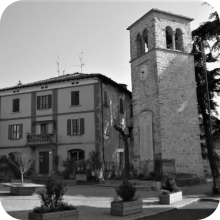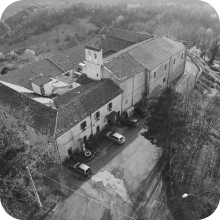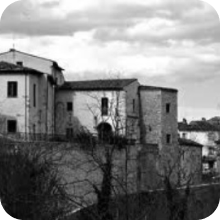04
PERSECUTION IN ITALY 1922-1943

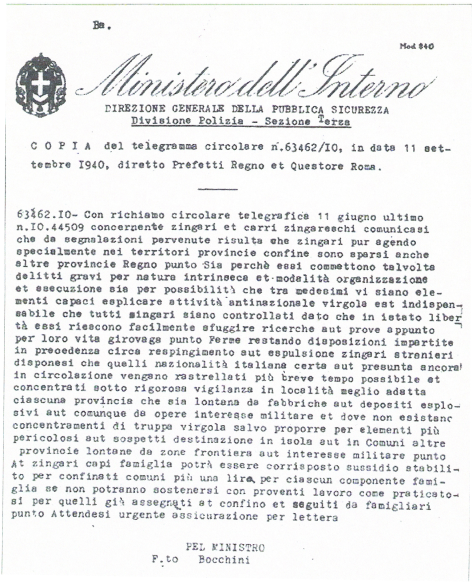
Order of internment in Italian concentration camps - 11 September 1940
Fascist discrimination of Roma and Sinti people progressively radicalised, until it progressed to blatant persecution and internment on an ethnic and racial grounds. Prior to this, it had begun with rejections and the forced removal of foreigners (or presumed foreigners) from the territory of the Kingdom, and continued, progressing to ethnic cleansing and internment.
On 11 September 1940, Arturo Bocchini, the Italian Chief of Police, ordered the prefects of the Kingdom of Italy to send families recognised as 'gypsies' to special concentration camps.
Border Rejections (1922-1938)
From 1922 onwards, Roma and Sinti people were frequently turned back at the border, as evidenced by reports of interrogations and repatriation orders.
On 19 February 1926, a circular sent to prefects specified that 'gypsies' were to be turned back, whatever their origin, even if they had valid documents for entry into Italy.
On 8 August of that same year, the Ministry of the Interior specified that the objective was to purge the country of the presence of caravans of 'gypsies', whose danger to public safety and hygiene went without saying.
“...that gypsies, circus people and the like who attempt to enter Italy in a caravan or on their own, even if they are in possession of a regular passport, be immediately expelled from all entry points.”

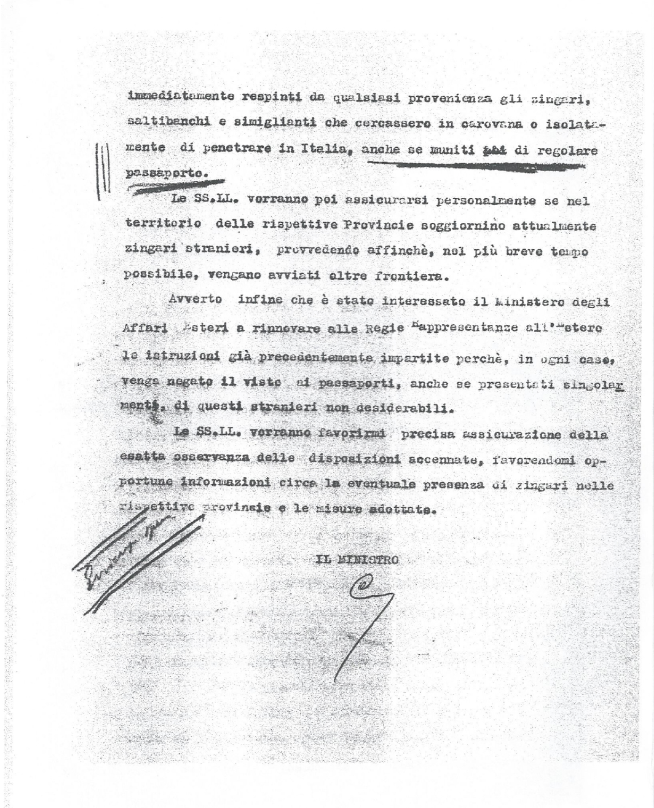
Circular dated 19 February 1926
Confinement and the case of the Roma and Sinti people of Istria
Fascists regarded the Italian Roma and Sinti people as active spies against the state, which is why they were often forced into exile. Especially in Istria, the eastern border of the Kingdom, which became the testing ground for Antigypsyism policy. On 17 January 1938, Arturo Bocchini, the Chief of Police, ordered a census of all Italian Sinti and Roma people living in Istria. Prefect Cimoroni responded with very detailed lists of names and between February and May 1938 the purge of this population from the borderlands was set in motion.
Entire families were boarded onto ferries and taken to Sardinia, between the provinces of Nuoro and Sassari. At least 80 people arrived on the island and then were dispersed into the countryside and controlled by the Carabinieri.
In the same year, the same expulsion practice was adopted for Sinti people living in Trentino, in the Kingdom of Italy, also guilty of representing a population considered racially dangerous.

Document detailing the confinement of Giuseppe Hudorovich in the Tremiti Islands
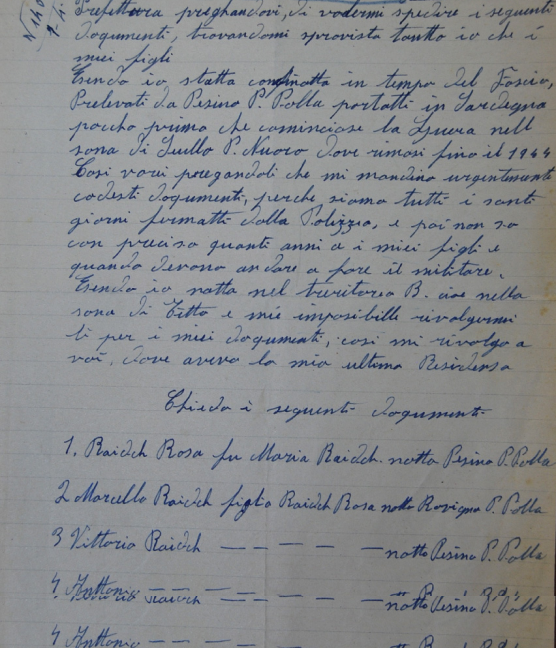
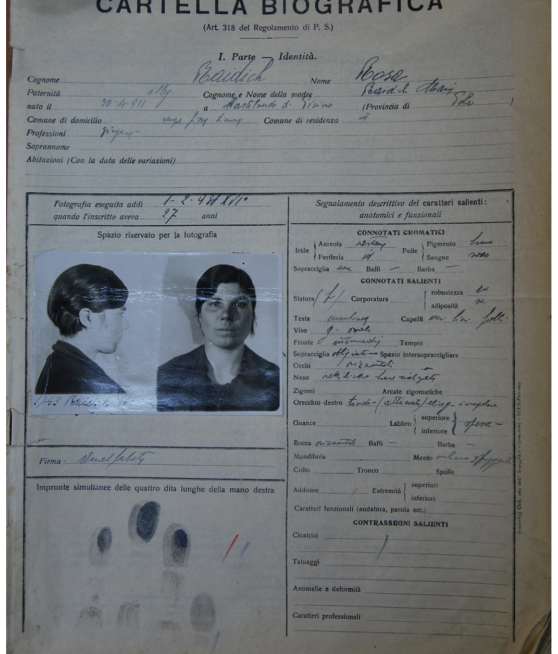

Rosa Rajdic's biographical file was drawn up for her confinement in Sardinia, which involved the villages of Chiramonti, Busachi, Ovodda, Perdasdefogu and Seulo. Her son Antonio was born in Busachi and her daughter Graziella, nicknamed ‘Lalla’, the last of a total of four siblings, was born in Perdasdefogu.
Rosa Rajdic's was also one of the first testimonies collected by scholar Mirella Karpati of the Centro Studi Zingari in Rome on the persecution of the Roma peoples in Italy. At the time, Perdasdefogu was described as a concentration camp because that is how it was also defined by Rajdic; the latest research has shown that it was a confinement camp.
Anna Poropat, with her children, was also among the Roma and Sinti families sent into exile in Sardinia, where she died in 1941.
Aldo Iaio Deragna lives in Milan today and is the son of Milan Milenko Deragna and Rosina Rosa Stepich. His parents, with their extended family, were exiled to Sardinia in the 1940s and the story of the family’s exile has been passed down orally, through the generations, to this day.
Mirko Gabrieli remembers the confinement of his family, taken from Trentino and sent to Sardinia.
The fascist concentration camps (1940-1943)
On 11 September 1940, Arturo Bocchini issued a decisive order reiterating a firm intention to combat the 'gypsy plague' by rounding up, arresting and concentrating all Italian Roma and Sinti families, and then imprisoning entire families in concentration camps. Being recognised as a 'gypsy' woman, man or child coincided with being considered dangerous 'by public rumour'.
The fascist movement began to set up a network of concentration camps reserved for Sinti and Roma people (along with other mixed concentration camps or for other categories of prisoners) on its territory.
The fascist concentration system collapsed after the armistice of 8 September 1943 and prisoners were thus able to escape.
The map indicates the places in the Kingdom of Italy where Roma and Sinti people were imprisoned, confined, deported and interned between 1922 and 1943.
The towns and villages have been identified by reference to archive documents. Only in a few cases are places mentioned that are mentioned in the direct testimonies of Sinti and Roma people who suffered Fascist persecution, where there is still no documentary evidence. The decision was made to leave a trace of these locations regardless, as a useful tool for future research and to enhance oral testimonies.

fascist concentration camp
Archival documents and testimonies confirm the presence of a fascist concentration camp for the civilian population to which Roma and Sinti people were deported and interned. In some cases they were concentration camps set up only for 'gypsies'.

place of confinement
A police operation consisting of an obligation imposed to reside in a place far from one's habitual place of residence, in particular because one is considered to be dangerous to society. In the case of Roma and Sinti people, the motivation for such an operation was related to the idea that 'gypsies' were dangerous.

place of imprisonment or forced stay
These are places where archived documentation confirms the presence of Sinti and Roma people in prisons or in fenced-off camps, set up temporarily after the incarceration of the caravans, to then send the arrested onto fascist concentration camps.

place of imprisonment/confinement reported by oral testimony but as yet unverified
These are places that are identified within current research, on the basis of oral testimony by a direct witness of Roma or Sinti deportation, which require further documentary confirmation.
Tap the map to zoom in
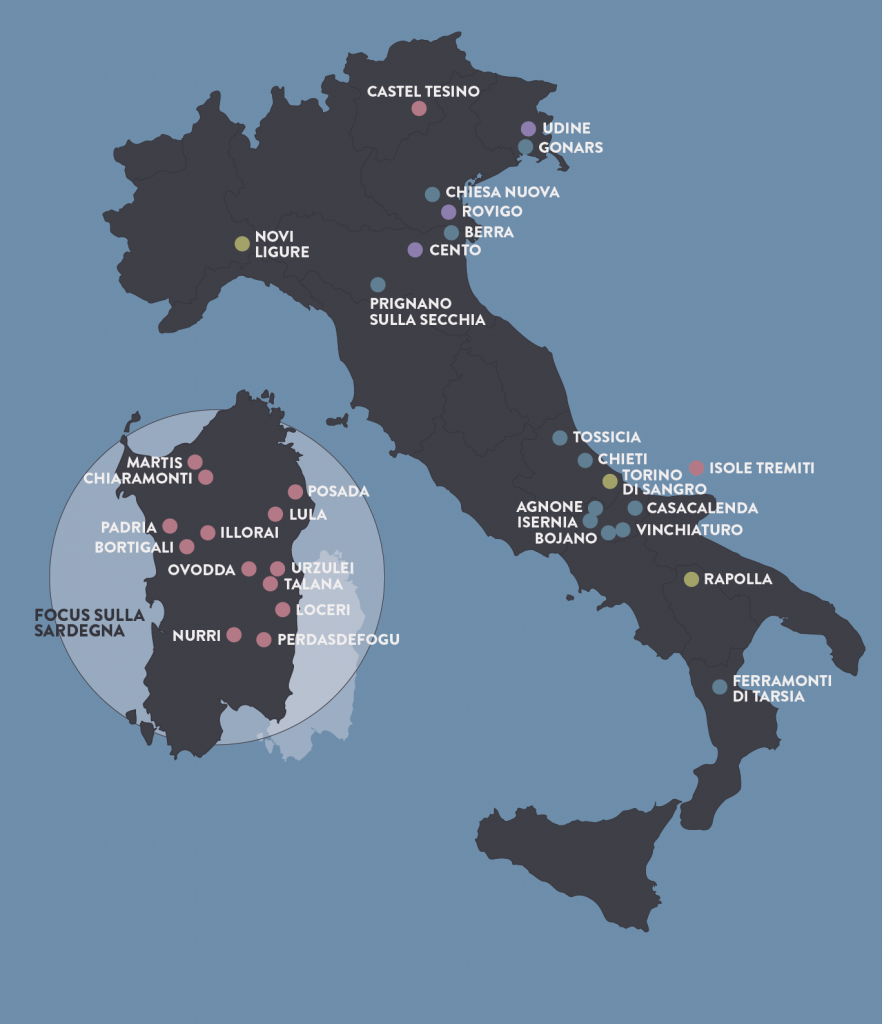
From Berra, to Cento, to the fascist concentration camp. A quick route to internment in Italy
The events surrounding the caravans of Sinti and Roma people passing through the area of Ferrara in the 1940s are presented here to show the progressive deprivation of freedom that was implemented subsequent to orders to round up and concentrate these people, signed by the Chief of Police in 1940. This implementation depended largely on the speed with which the prefects and police forces drew up censuses or simply stopped and herded the passing caravans together in specific areas. This is the case of a caravan consisting of the Roma Campos and Rossetto families who, having been stopped and arrested, were first placed in an agricultural area near the village of Berra, where the space was surrounded with barbed wire, becoming a sort of forced rest camp, and then sent to the prisons at the Rocca di Cento. The families were then moved from their cells to the concentration camp in Bojano, in the province of Campobasso. This was the place to which all Roma and Sinti people who had been arrested and detained in Italy since September 1940 were directed.
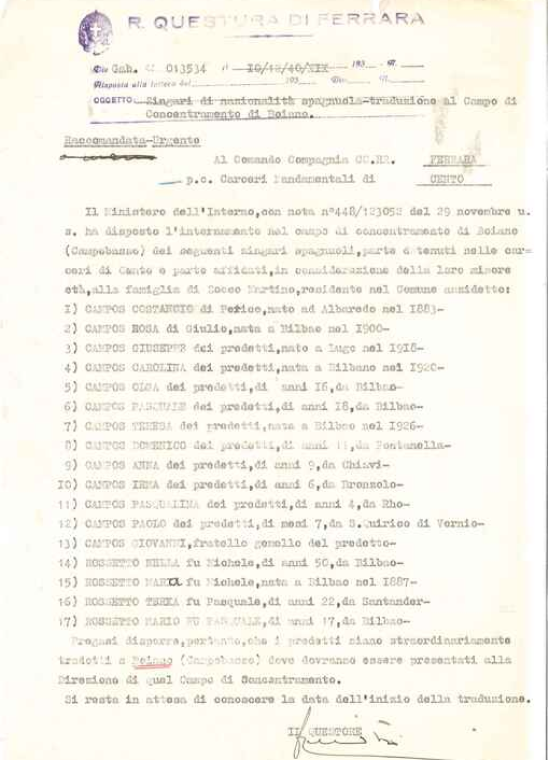
Gypsies from the prisons of Cento to the Bojano concentration camp

